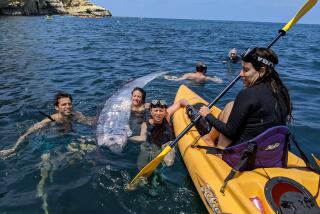Sharks are thriving in Southern California but dying in the San Francisco Bay, experts say

Beached shark in San Francisco Bay (Pelagic Shark Research Foundation)
The California coast is teeming with young sharks, as warming waters and abundant food have created the ideal conditions for feeding, according to experts.
In Southern California, great white sharks have begun to arrive after spending the winter off Baja California. Recently, one of the sharks bit a chunk out of a motherâs leg as she swam off San Onofre State Beach.
The woman, 35-year-old Leanne Ericson of Vista, remains in critical condition and has undergone two of several surgeries scheduled for her injuries, the San Diego Union-Tribune reported.
She lost a lot of blood and was temporarily in an induced coma.
âWe are grateful for all of the concern, prayers and good wishes we have received in recent days from the many friends and strangers who have reached out to us from across the country, and indeed, the world,â read a statement from Ericsonâs family, released to the Union-Tribune through Scripps Memorial Hospital La Jolla. âThe situation could have been far graver had it not been for the number of emergency response personnel and others who provided the care she needed and saved her life.â
Chris Lowe, a biology professor and director of the Shark Lab at Cal State Long Beach, said the shark that attacked Ericson on Saturday was likely not a full grown adult and mistook her for food. Typically, young great whites will feed on fish and rays.
âThey have to learn to feed on their own and theyâre naĂŻve,â Lowe said. âThey donât know how to chase down big prey.â
Adult great whites feed on sea lions and other marine life off islands such as Catalina and San Nicholas, Lowe said. Though itâs not exactly known where the mothers give birth, their babies immediately head toward the shore once theyâre born. The sharks are normally off the Southlandâs shores between May and October.
But last year, warm waters triggered by El NiĂąo conditions kept the sharks here longer into the winter and drew them back earlier in the spring. Some of the 2- and 3-year-old sharks are here again earlier this year, Lowe said, though heâs not sure why.
âMaybe it just wasnât cold enough to move those migrations. We just donât know whatâs going on this year,â Lowe said.
But thatâs not the only shark mystery this year.
In San Francisco Bay, a huge die-off of leopard sharks and bat rays has sparked concerns among marine life experts.
For weeks now, dead leopard sharks â newborns and mature adults â have been washing up on beaches from San Mateo to Bolinas. Officials with the Pelagic Shark Research Foundation in Monterey believe years of debris, trash and chemical waste pent up in Bay Area storm drains and waterways have finally been washed into the bay due to this winterâs epic storms and are killing the creatures that live there.
Tide gates inside the bay that close during high tide to prevent flooding during a storm can also trap sharks and bat rays in the bay, where theyâre then exposed to, and unable to escape, toxic runoff.
âThis is an issue of San Francisco Bay sharks and associated wildlife being exposed to toxic watershed ⌠due to Tide Gate entrapment and subsequent discharges into the San Francisco Bay,â the center wrote on Facebook last week.
At the peak of the die-off, dozens of dead sharks were found daily along the coastline, the foundation said. The number of dead sharks has begun to drop in the last week.
In Southern California, however, the shark population is thriving.
On Thursday, Orange County Sheriffâs Sgt. Steve Marble said deputies with the harbor patrol in Dana Point spotted a group of four 6- to 8-foot great whites at the surf line.
Other popular areas for sharks this year include Ventura, Santa Monica and Belmont Shores, Lowe said.
âWeâve learned that these baby white sharks are temperature- sensitive and they donât like temperatures above 80 degrees. They have this sweet spot, and Southern California is the perfect place from late spring to mid-fall,â Lowe said. âThen Baja becomes the sweet spot.â
Loweâs researchers recently tracked a 1-year-old shark that stayed around Huntington Beach for 30 days, then moved up to Santa Monica in a matter of hours. It stayed there for a month.
Despite the public panic a shark attack can create, Lowe says the coastline is safe if you look at statistics.
âItâs horribly unfortunate these things happen, but the reality is people are going to go out surfing and itâs not something that happens every day,â he said. âAccidents do happen and thatâs what we think these are. Thereâs no indication these sharks have any penchant for eating people.
âOtherwise, Huntington Beach would be a one-stop shop for sharks in the Pacific,â he joked.
When young sharks have attacked, it has typically been when swimmers have been alone, farther out in the water and along remote stretches of beach not crowded with hundreds or thousands of other people.
For breaking California news, follow @JosephSerna on Twitter.
ALSO
Insects and disease are ravaging the Southlandâs urban trees. Whoâs going to stop them?
Photos: Snowmelt causes flooding in Yosemite Valley
Late-spring rainstorm will hit Southern California this weekend
UPDATES:
3:05 p.m.: This article was updated with the condition of Saturdayâs shark attack victim.
This article was originally published at 10:55 a.m.
More to Read
Sign up for Essential California
The most important California stories and recommendations in your inbox every morning.
You may occasionally receive promotional content from the Los Angeles Times.











